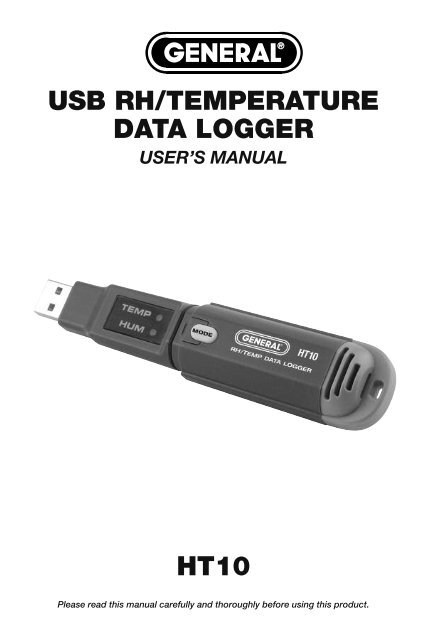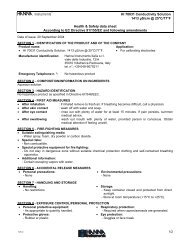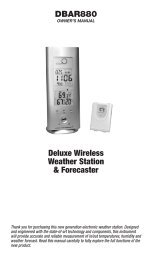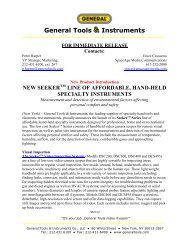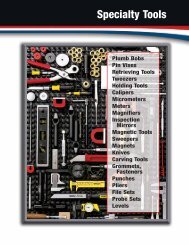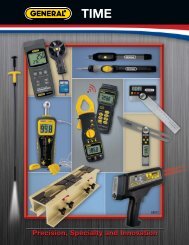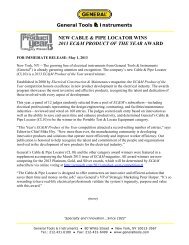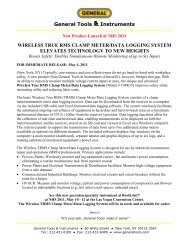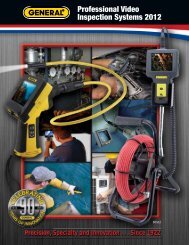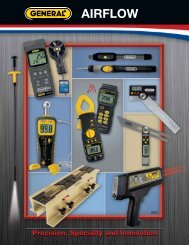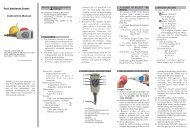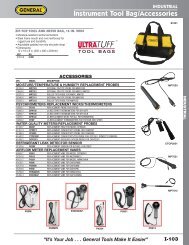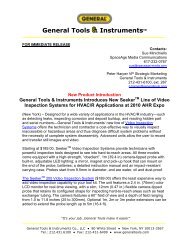usb rh/temperature data logger ht10 - General Tools And Instruments
usb rh/temperature data logger ht10 - General Tools And Instruments
usb rh/temperature data logger ht10 - General Tools And Instruments
You also want an ePaper? Increase the reach of your titles
YUMPU automatically turns print PDFs into web optimized ePapers that Google loves.
USB RH/TEMPERATURE<br />
DATA LOGGER<br />
USER’S MANUAL<br />
HT10<br />
Please read this manual carefully and thoroughly before using this product.
TABLE OF CONTENTS<br />
Introduction . . . . . . . . . . . . . . . . . . . . . . . . . . . . . . . . . . 3 –4<br />
Key Features . . . . . . . . . . . . . . . . . . . . . . . . . . . . . . . . . 4 –5<br />
Safety Instruction . . . . . . . . . . . . . . . . . . . . . . . . . . . . . . . . . 5<br />
What’s in the Blister Pack. . . . . . . . . . . . . . . . . . . . . . . . . . . 5<br />
Product Overview. . . . . . . . . . . . . . . . . . . . . . . . . . . . . . . . . 6<br />
Setup Instructions . . . . . . . . . . . . . . . . . . . . . . . . . . . . 7 – 12<br />
Installing/Replacing the Battery . . . . . . . . . . . . . . . . . 7<br />
Install Software and Drivers. . . . . . . . . . . . . . . . . 7 –9<br />
Configure the Unit . . . . . . . . . . . . . . . . . . . . . . . 9 – 12<br />
Operating Instructions . . . . . . . . . . . . . . . . . . . . . . . . 13 – 16<br />
Deploy the Unit . . . . . . . . . . . . . . . . . . . . . . . . 13 – 14<br />
Stop Logging and Import Logs . . . . . . . . . . . . . . . . . 14<br />
Viewing, Printing and Exporting Data Logs . . . . 14 – 16<br />
Other Indications . . . . . . . . . . . . . . . . . . . . . . . . . . . 16<br />
Specifications . . . . . . . . . . . . . . . . . . . . . . . . . . . . . . . . . . 17<br />
Maintenance Tips. . . . . . . . . . . . . . . . . . . . . . . . . . . . . . . . 18<br />
Warranty Information . . . . . . . . . . . . . . . . . . . . . . . . . . . . . 18<br />
Return for Repair Policy . . . . . . . . . . . . . . . . . . . . . . . . . . . 19<br />
2
INTRODUCTION<br />
Thank you for purchasing <strong>General</strong> <strong>Tools</strong> & <strong>Instruments</strong>’<br />
HT10 USB RH/Temperature Data Logger. Please read this<br />
user’s manual carefully and thoroughly before using the<br />
instrument.<br />
The HT10 is a low-cost, compact, battery-powered thermohygrometer<br />
capable of unattended logging (recording) of the<br />
ambient <strong>temperature</strong> and relative humidity (RH) of an<br />
environment for days, weeks or months. Data logging can<br />
be started or stopped by pushing a button on the unit,<br />
eliminating the need to bring a laptop to the job site.<br />
After a <strong>data</strong> log has been captured and stored, it can be<br />
uploaded as a .txt file to any PC running the Windows ® 7 or<br />
Windows ® XP operating system after plugging the HT10 into<br />
one of the computer’s USB ports. The HT10’s internal flash<br />
memory is large enough to store up to 8000 pairs of humidity<br />
and <strong>temperature</strong> readings.<br />
Included with the product—which is slightly larger than a<br />
thumb drive—is a mini-disc with the drivers needed to<br />
interface the unit to the computer, as well as software that<br />
can display a <strong>data</strong> log file as a table or graph and/or export it<br />
to Microsoft Excel. Exporting to Excel is recommended for<br />
sophisticated trending and analysis of humidity and<br />
<strong>temperature</strong> <strong>data</strong> and easy detection of unexpected<br />
excursions.<br />
Windows<br />
3<br />
® 7 and Windows ® XP are registered trademarks of Microsoft Corporation.
Applications for the HT10 include:<br />
• Water damage restoration—Because the HT10 is<br />
designed to be deployed and left in place over the<br />
duration of the job, it is always in equilibrium with the<br />
environment.<br />
• Process control—The HT10 enables, simplifies and cuts<br />
the cost of environmental monitoring of office buildings,<br />
greenhouses, food and equipment storage facilities,<br />
wineries, freezers, shipping containers, HVAC/R<br />
installations, computer rooms, labs, libraries, museums<br />
and saunas.<br />
• Electronics manufacturing—Alerts provided by the lowhumidity<br />
alarm function of the HT10 can mitigate the risk<br />
of damaging high-voltage static discharges.<br />
KEY FEATURES<br />
• One button starts/stops <strong>data</strong> logging without a PC<br />
• Plug-and-play USB 2.0 interface; no need for cables,<br />
cradles or docks<br />
• Large storage capacity: Up to 8000 pairs of humidity and<br />
<strong>temperature</strong> readings<br />
• Two LEDs indicate device working status and<br />
“memory full”<br />
• Included software is used to set: Sampling time from<br />
10 seconds to 12 hours; Hi/Lo alarm setpoints for<br />
humidity and <strong>temperature</strong>; Temperature unit (°F or °C)<br />
• Software also calculates dew point and displays <strong>data</strong> logs<br />
as time-based graphs synchronized to your PC’s clock<br />
4
• One-click exporting of logs to Excel or Word<br />
• Long battery life (up to one year)<br />
• Includes USB extension cable<br />
• One-year warranty<br />
SAFETY INSTRUCTION<br />
Do not use the HT10 in the presence of flammable or<br />
explosive gases.<br />
WHAT’S IN THE BLISTER PACK<br />
The HT10 comes in a blister pack that also contains<br />
• One “1/2 AA” battery<br />
• A disc with software drivers for Windows7 or Windows<br />
XP computers, a program for capturing <strong>data</strong> logs and<br />
displaying them as curves, and a PDF of this user’s<br />
manual<br />
• A USB extension cable<br />
• A hard copy of this user’s manual (inside the fold-over<br />
card)<br />
5
PRODUCT OVERVIEW<br />
Fig. 1 shows the main components, controls, display and<br />
connectors of the HT10. Familiarize yourself with their names<br />
and functions before moving on to the Setup Instructions.<br />
A. Temperature and humidity sensor window<br />
B. Battery compartment (latch is on rear of unit)<br />
C. Two-color (green and red) LEDs (indicate device logging<br />
and configuration status and “memory full”)<br />
D. USB plug<br />
E. Protective cap<br />
F. MODE button<br />
6<br />
E<br />
D<br />
B<br />
C<br />
F<br />
A
SETUP INSTRUCTIONS<br />
INSTALLING/REPLACING THE BATTERY<br />
LATCH<br />
The HT10 uses a 3.6VDC “1/2 AA” Lithium-ion battery.<br />
To open the battery compartment, use a paper clip or a<br />
screwdriver with a fine point to push in the silver flange<br />
showing through the small square hole in the rear of the unit<br />
(left photo above). Push back the cover (middle photo),<br />
remove the old battery (right photo) and insert a fresh battery<br />
in the correct orientation. Then replace the cover, pushing it<br />
forward until you feel and hear a click.<br />
Whenever you change the battery, each of the two LEDs will<br />
flash red once, and then green once.<br />
Note: If the battery is removed from a unit before it has been<br />
set up from software or while it is recording, the unit must be<br />
reconfigured before it can be reactivated. If it is not<br />
reconfigured, the unit will remain in standby mode.<br />
INSTALL SOFTWARE AND DRIVERS<br />
1. Place mini-disc in tray of CD/DVD drive, shiny side down.<br />
Close tray.<br />
2. When the AutoPlay window appears, click on “Open folder<br />
to view files using Windows Explorer.”<br />
3. Windows Explorer will indicate that there are two “Files<br />
Currently on the Disc”. One is actually a folder containing<br />
a PDF of the HT10 user’s manual (as well as PDFs of the<br />
manuals for the HT20 and HT50—versions of the HT10<br />
7
with LCDs). Copy the HT10 manual to your computer’s hard<br />
drive for permanent storage. The other file is a Windows<br />
Installer Package (.msi file) named “ELUSB V1.0”. Doubleclick<br />
its icon.<br />
4. A window titled “Welcome to the ELUsb Setup Wizard”<br />
will appear. Click Next to continue.<br />
5. Within the window that appears next, click the box next to<br />
“I accept the terms in the License Agreement”. Then click<br />
Next to continue.<br />
6. The next window advises that the ELUSB application will<br />
be installed in your computer’s C:\Program Files folder in a<br />
new subfolder named . If you want to install the<br />
software elsewhere, click Browse and choose another<br />
location. After selecting either the default location or<br />
another location, click Next to continue.<br />
7. When the “Ready to install ELUsb” window appears, click<br />
Install to continue.<br />
8. Before the installation begins, a User Account Control<br />
window may appear and ask, “Do you want to allow<br />
[ELUSB V1.0.msi] to make changes to this computer?”<br />
Click Yes to continue.<br />
9. The ELUsb Setup Wizard will now install the program on<br />
your computer. On the next window that appears, click<br />
Finish.<br />
10. At the bottom of the Device Driver Installation Wizard that<br />
appears next, click Next to continue.<br />
11. The next window to appear is a Windows Security<br />
window. Click on “Install this driver software anyway” to<br />
continue.<br />
8
12. The next Device Driver Installation Wizard window will<br />
advise you that an HT10/20/50 driver from <strong>General</strong> <strong>Tools</strong><br />
or Kecheng Laboratories was successfully installed and<br />
that your device is now “Ready to use.” Click Finish to<br />
continue.<br />
CONFIGURE THE UNIT<br />
Note that the software installation has added a icon to<br />
your desktop. To facilitate access to the program, right-click<br />
on the icon and pin it to both your Start button and the Quick<br />
Start area at the left of your taskbar. You can now eject the<br />
installation mini-disc and store it with your other important<br />
software.<br />
Plug the HT10 into an available USB port of your computer. If<br />
your computer is a laptop and the only available USB jack<br />
does not have enough vertical clearance to accommodate<br />
the HT10 without mechanically stressing its USB plug, do<br />
not plug the HT10 directly into the jack. You do not want<br />
the plug of the HT10 to support any of the weight of the<br />
laptop. If that is the case, plug the HT10 into the jack of the<br />
included USB extension cable and insert the plug of the<br />
extension cable into the computer’s USB jack.<br />
The first time you plug the HT10 into your computer, your<br />
system tray will notify you that the computer is “Installing<br />
Device Driver Software”. When the notification disappears,<br />
open the ELUSB program by selecting it via your Start button,<br />
clicking on its icon on your taskbar, or double-clicking its<br />
desktop icon.<br />
If the software has installed correctly and you have plugged<br />
the HT10 into a working USB port of your computer, the<br />
following screen should appear on your computer’s display.<br />
9
10<br />
Device HT10 is connected!<br />
Fig. 2. The three options made available by<br />
plugging the HT10 into a USB port<br />
Note: If you have already used your HT10 to log <strong>data</strong><br />
and it is still in recording mode, plugging the unit in<br />
will cause the following window to appear.<br />
Click Yes to stop recording and import all <strong>data</strong> recorded to<br />
that point in time. Click No to continue to Setup without<br />
importing recorded <strong>data</strong> (meaning it will be lost). Click<br />
Cancel to go back and unplug the unit from the USB port.
You can now use the software to “configure” your HT10.<br />
Configuring the device means choosing four key parameters:<br />
• Sampling time—How often it makes and stores<br />
humidity and <strong>temperature</strong> measurements.<br />
• Temperature unit—degrees Fahrenheit or Celsius<br />
(°F or °C).<br />
• High and low <strong>temperature</strong> alarm setpoints<br />
• High and low humidity alarm setpoints<br />
To begin, click on “Set up the USB Data Logger” in the<br />
window shown in the figure above. Doing so will cause the<br />
following window to appear.<br />
Device HT10 is connected!<br />
Fig. 3. The HT10 configuration (Setup) window<br />
Using your mouse, trackball or touchpad, first choose your<br />
Temp Scale and Sample Rate (sampling time). With regard to<br />
sampling time, using the shortest setting of 10 seconds may<br />
11
esult in too much essentially identical <strong>data</strong> being stored in<br />
memory, potentially limiting its capacity to capture important<br />
events such as an unexpected excursion of <strong>temperature</strong> or<br />
humidity. Conversely, using the longest sampling time setting<br />
of 12 hours will likely cause important events to go<br />
undetected.<br />
If you are an experienced <strong>data</strong> <strong>logger</strong>, you already know how<br />
to choose the optimum sampling time for your application. If<br />
you are a novice, pick a sampling time closer to the minimum<br />
sampling time than the maximum, on the assumption that the<br />
HT10 probably has enough memory (8000 pairs of humidity<br />
and <strong>temperature</strong> readings) to store all the <strong>data</strong> you ask the<br />
meter to log—unless you use it to log <strong>data</strong> for months, rather<br />
than weeks or days.<br />
If you wish, you can also drag the sliders shown in the figure<br />
to set high and low alarm setpoints for <strong>temperature</strong> and<br />
humidity.<br />
Once you have chosen your <strong>data</strong> logging parameters, click<br />
Setup. A window will appear advising that “The device is set<br />
up successfully.” Clicking Setup also synchronizes the HT10’s<br />
internal clock with your computer’s clock, giving all <strong>data</strong> logs<br />
to be captured an absolute time reference.<br />
You can now unplug the HT10 from your computer’s USB port.<br />
The unit is in “standby” mode, ready to begin logging <strong>data</strong>.<br />
12
OPERATING INSTRUCTIONS<br />
DEPLOY THE UNIT<br />
The HT10 is particularly easy to deploy on a job site because<br />
the unit does not need to be plugged into a computer to be<br />
activated (ready to start logging <strong>data</strong>). Working together, the<br />
MODE button and the pair of two-color LEDs (Fig. 1, Callouts<br />
F and C) serve as the control and indicators needed to: 1)<br />
start and stop <strong>data</strong> logging and 2) verify and change the unit’s<br />
working status.<br />
That leaves only two things to be sure of when choosing a<br />
place to deploy the HT10:<br />
• The <strong>temperature</strong> and humidity sensor window<br />
(Fig. 1, Callout A) is not covered<br />
• The humidity and <strong>temperature</strong> values at the unit’s<br />
location are “representative” of the room<br />
The HT10—with its protective cap on—can be deployed<br />
either by laying it on a horizontal surface or by hanging it<br />
vertically within the included plastic mounting bracket. The<br />
back of the bracket features both a magnet and a hanger<br />
hole.<br />
Once you have deployed the HT10, you can initiate <strong>data</strong><br />
logging. To start <strong>data</strong> logging, press and hold the MODE<br />
button for at least 3 seconds. Both LEDs will flash green<br />
twice to confirm that logging has begun.<br />
STOP LOGGING AND IMPORT LOGS<br />
To stop <strong>data</strong> logging, press and hold the MODE button for at<br />
least 3 seconds. Both LEDs will flash red 2 or 3 times to<br />
confirm that logging has stopped.<br />
13
That is how you should stop <strong>data</strong> logging if you plan to initiate<br />
another logging session later without uploading logged <strong>data</strong><br />
to your computer in the interim. If you allow logging to<br />
continue and you do not upload your <strong>data</strong> to your computer<br />
soon, you risk filling up the HT10’s memory.<br />
A simpler and safer way to stop <strong>data</strong> logging is to plug the<br />
HT10 into your computer’s USB port immediately after<br />
completing a logging session and then use the ELUSB<br />
software to stop logging.<br />
Each time you plug the HT10 into the USB port, the window<br />
shown in Fig. 2 will appear. When you plug in the unit, it<br />
makes no difference whether it is still logging; the procedure<br />
for uploading (importing) <strong>data</strong> logs is identical. Just click on<br />
the middle selection—Stop the USB Data Logger and<br />
download <strong>data</strong>—to instantly execute both functions. The<br />
<strong>data</strong> will be imported as a .txt file. A “Save As” window will<br />
appear, asking you to identify where you want the file to be<br />
stored and what you want to name it.<br />
VIEWING, PRINTING AND EXPORTING<br />
DATA LOGS<br />
Immediately after you close the “Save As” window by<br />
clicking on Save, the uploaded <strong>data</strong> log will automatically be<br />
displayed as a set of curves representing all loggable values.<br />
Fig. 4 is a typical example. The initial display includes all<br />
parameters, including dew point (which the software<br />
automatically calculates) and alarm setpoints that you may<br />
have entered during Setup. To remove any parameter or<br />
horizontal and vertical grid lines from the overall plot, uncheck<br />
its box at right.<br />
14
Fig. 4. A typical initial plot of an imported <strong>data</strong> log<br />
There are several features shown in Fig. 4 worth noting:<br />
• To mark the position of every recorded <strong>data</strong> point on the<br />
curve, check the “Mark Points” box at the top of the sidebar<br />
at right.<br />
• To get a higher-resolution view of the <strong>data</strong> recorded during<br />
a specific period of time, scale up and down the curves by<br />
dragging the slider at the bottom of the window left and<br />
right.<br />
• Hovering the cursor over a particular point of the curve<br />
displays all <strong>data</strong> related to this point—including the<br />
maximum, minimum and average values of the entire<br />
curve—in a shaded box at upper left.<br />
• The dates and times shown on the x-axis scale and in the<br />
upper left corner are in sync with your computer’s clock.<br />
• To print the .txt file of any <strong>data</strong> log, click the Print virtual<br />
button.<br />
15
• To open a previously saved <strong>data</strong> log, click the Open<br />
button. This function is also available as the “View<br />
previously saved <strong>data</strong>” option shown in Fig. 2.<br />
• To export a file to Excel for advanced trending and<br />
analysis, click the Export to Excel button.<br />
OTHER INDICATIONS<br />
As mentioned earlier, the MODE button and the pair of twocolor<br />
LEDs work together to indicate the current working<br />
status of the HT10. For example, the MODE button can be<br />
used to confirm whether or not the unit has been configured<br />
(activated) using the software’s Setup window (see Fig. 3):<br />
• If the unit is ready to log <strong>data</strong>, a quick press of the<br />
MODE button will cause both LEDs to flash green once.<br />
• If the HT10 needs to be configured, the two LEDs will<br />
alternately flash red and green twice.<br />
If a quick press of the MODE button causes both LEDs to<br />
flash red once, logging has been stopped because the<br />
memory is full.<br />
During <strong>data</strong> logging, the pair of two-color LEDs will flash<br />
green or red to indicate whether measured humidity and<br />
<strong>temperature</strong> values are within or outside the band between<br />
the preset low and high alarms:<br />
• The LEDs will alternately flash green one time each if<br />
the values of both parameters have not exceeded their<br />
setpoints.<br />
• The LEDs will alternately flash red one time each if the<br />
value of either parameters has exceeded its setpoints.<br />
16
SPECIFICATIONS<br />
Temperature Measurement Range -4° to 158°F (-20° to 70°C)<br />
Temperature Measurement Accuracy ±0.7°F (0.4°C)<br />
Temperature Measurement<br />
Resolution and Repeatability<br />
±0.2°F (0.1°C)<br />
Relative Humidity (RH)<br />
Measurement Range<br />
10 to 90%<br />
RH Measurement Accuracy ±3%<br />
RH Measurement Resolution<br />
and Repeatability<br />
±0.1%<br />
Internal Storage Capacity 8,000 pairs of RH/Temp<br />
readings<br />
Temperature Response Time 0.5 seconds<br />
Humidity Response Time 5 seconds<br />
Interface USB 1.0/2.0<br />
Length of USB Extension Cable 7.9 in. (200mm)<br />
Dimensions 4.96 x 1.10 x 2.01 in.<br />
(126 x 28 x 51 mm)<br />
Weight
MAINTENANCE TIPS<br />
• Avoid dropping the unit. Do not subject it to violent shock<br />
or vibration or expose it to strong electromagnetic fields<br />
(for example, near arc welders or induction heaters).<br />
• Keep the unit out of direct sunlight.<br />
• Do not use chemicals or abrasive cloth to clean the<br />
display window or housing.<br />
• Before storing the HT10 for an extended period of time<br />
(several months or more), remove the battery to avoid<br />
having it leak and damage the unit.<br />
WARRANTY INFORMATION<br />
<strong>General</strong> <strong>Tools</strong> & <strong>Instruments</strong>’ (<strong>General</strong>’s) HT10 USB RH/Temperature<br />
Data Logger is warranted to the original purchaser to be free from<br />
defects in material and workmanship for a period of one year.<br />
Subject to certain restrictions, <strong>General</strong> will repair or replace this<br />
instrument if, after examination, the company determines it to be<br />
defective in material or workmanship.<br />
This warranty does not apply to damages that <strong>General</strong> determines<br />
to be from an attempted repair by non-authorized personnel or<br />
misuse, alterations, normal wear and tear, or accidental damage—<br />
including dropping the unit. The defective unit must be returned to<br />
<strong>General</strong> <strong>Tools</strong> & <strong>Instruments</strong> or to a <strong>General</strong>-authorized service<br />
center, freight prepaid and insured.<br />
Acceptance of the exclusive repair and replacement remedies<br />
described herein is a condition of the contract for purchase of<br />
this product. In no event shall <strong>General</strong> be liable for any incidental,<br />
special, consequential or punitive damages, or for any cost,<br />
attorneys’ fees, expenses, or losses alleged to be a consequence<br />
of damage due to failure of, or defect in any product including,<br />
but not limited to, any claims for loss of profits.<br />
18
RETURN FOR REPAIR POLICY<br />
Every effort has been made to provide you with a reliable product<br />
of superior quality. However, in the event your instrument requires<br />
repair, please contact our Customer Service to obtain an RGA<br />
(Return Goods Authorization) number before forwarding the unit via<br />
prepaid freight to the attention of our Service Center at this address:<br />
<strong>General</strong> <strong>Tools</strong> & <strong>Instruments</strong><br />
80 White Street<br />
New York, NY 10013<br />
212-431-6100<br />
Remember to include a copy of your proof of purchase, your return<br />
address, and your phone number and/or e-mail address.<br />
19
GENERAL TOOLS & INSTRUMENTS<br />
80 White Street<br />
New York, NY 10013-3567<br />
PHONE (212) 431-6100<br />
FAX (212) 431-6499<br />
TOLL FREE (800) 697-8665<br />
e-mail: sales@generaltools.com<br />
www.generaltools.com<br />
HT10 User’s Manual<br />
Specifications subject to change without notice<br />
©2012 GENERAL TOOLS & INSTRUMENTS<br />
NOTICE - WE ARE NOT RESPONSIBLE FOR TYPOGRAPHICAL ERRORS.<br />
MAN#HT10 3/16/12


